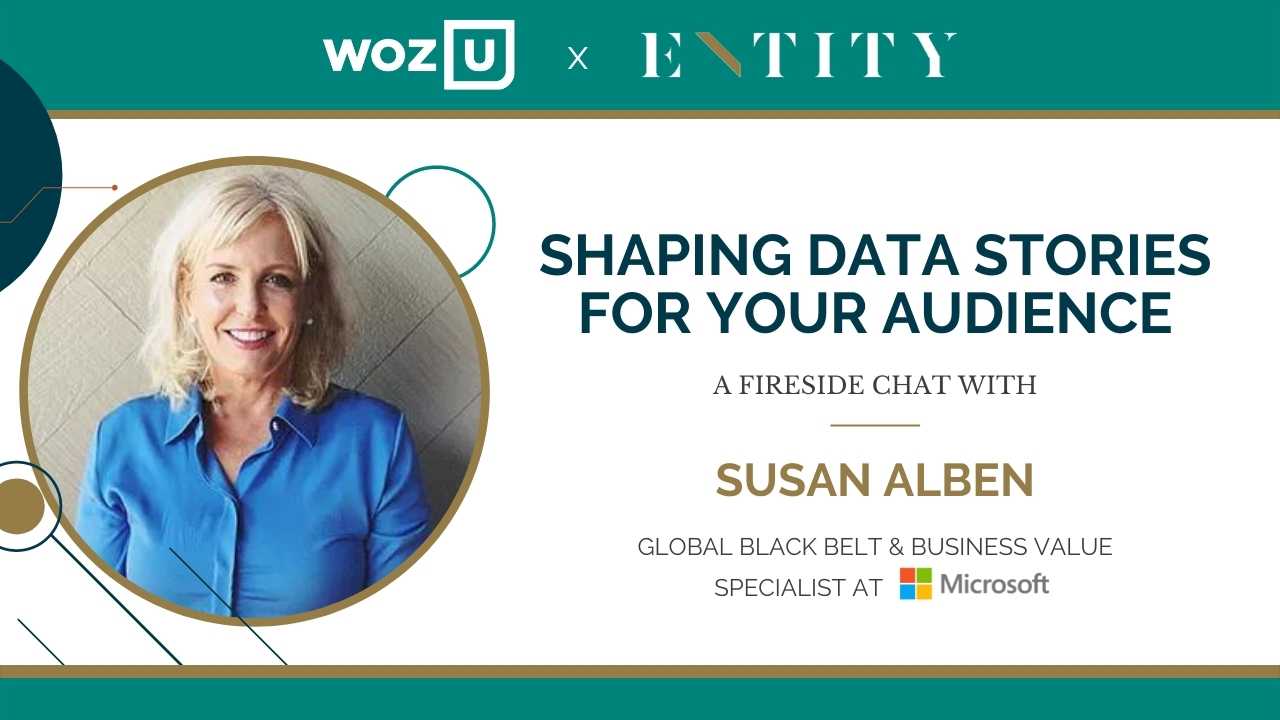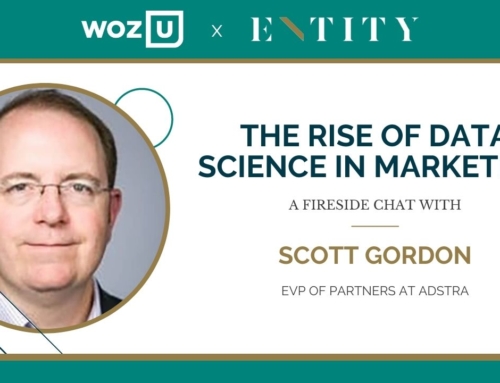WOZ and ENTITY Academy hosted a Fireside Chat with special guest Susan Alben, a Business Value Specialist and Global Black Belt at Microsoft. The chat was moderated by national TV journalist and news anchor Stephanie Stanton.
Data-driven careers are everywhere. But it’s not enough for data scientists to be able to extract, organize and analyze numbers – they need to be able to put those numbers into perspective. It’s especially critical when you are presenting to customers, stakeholders, and even government entities. This is where storytelling with data comes into play.
Who is Susan Alben?
Susan Alben is a Business Value Specialist at Microsoft and an ENTITY Academy mentor. Alben’s job is essentially to examine companies and determine if there is a value in digitally transforming their organization—and if so where that value lies. She advises businesses on how Microsoft’s AI or cloud technologies could improve their processes or increase their sales to ultimately help them make informed decisions to stay competitive in the market.
Alben is passionate about increasing the number of women in STEM fields, so this was not her first time talking to mentees at ENTITY Academy about careers in data science. She stressed the importance of having a diverse group of people examining data and telling data stories. She also emphasized that this is especially true if a company is looking into using AI to determine who receives mortgages or healthcare coverage.
“Not enough women are represented in the demographic of people that are looking into data,” Alben said.
A large part of what Alben does at Microsoft is using data stories to present solutions to investors, making her the perfect guest speaker for this particular topic.
What is Data Storytelling?
Alben explained that she transforms datasets into compelling stories by using her own intuition and experiences, to “add flavor” to the otherwise one-note readouts.
She gave some examples of classic narratives and how a data storyteller acts sort of like a “mentor” figure for a company. They can inform and inspire like Mr. Miyagi and the Karate Kid, or Cinderella and her Fairy Godmother. Alben herself likes to think of herself as the “Q” to a company’s “James Bond” – explaining how to find the best tech tools for the job and how the company should best use it to complete its mission.
Alben also stressed that you also need to shape your data story to your audience. She explained that executives are busy people who do not have time to speculate on why the data is the way that it is. Data storytellers need to come into meetings with ideas and explanations for what trends emerged from the data and what can be done to maximize the current momentum or shift directions if needed.
Why Do We Tell Data Stories?
Storytelling has long been recognized as an integral way to present information that people will absorb and remember. In data science, it’s important to be able to get information across in an understandable way, so making a narrative out of numbers will help your audience absorb the information better.
Alben broke down some of the different reasons that organizations analyze data and present it to others in a story format. For example, environmentalists could use a data story to sound “alarm bells” to try and explain to organizations and politicians what changes need to be done quickly in order to prevent the polar ice caps from melting.
Many companies use data to identify patterns and anticipate what will happen in the future based on what they have already seen. This allows businesses to troubleshoot and implement preventative measures, or set themselves ahead of the curve to avoid pitfalls their competitors may fall into.
In for-profit organizations, executives need to know if they should increase their market share or improve their time to market. They can also use data to learn about risk and exposure. Primarily, they want to make sure that they can retain existing customers, but they also need to be on the lookout for security risks.
Alben’s work at Microsoft enables her to use data to help her clients draw conclusions from the data they already generate to make even better business decisions.
Data Storytelling vs. Data Visualization
Data visualization is a pretty significant part of data storytelling. If people who might not be numerically inclined can visualize a line graph showing plummeting profits or a pie chart of public opinions, it’s easier to wrap their heads around what the data actually means.
This is one of the reasons why infographics have become so popular in journalism and digital marketing. One clever infographic (about infographics!) created by SMA Marketing showed that posts with some sort of data visualization are liked and shared almost three times more than any other content on social media, and colorful content is said to increase reader attention span up to 82 percent.
But digital storytelling goes deeper than just visualizing the data. It’s about creating a narrative around the people or issues involved in the story. Showing your company’s investors charts will certainly help them get an idea of how well they’re doing, but what they really want to know is why the numbers are the way that they are and how to change or maintain these numbers.
At the end of the day, investors care the most about the bottom line, which means your data storytelling needs to revolve around that, which is exactly what Susan Alben set out to discuss with WOZ and ENTITY Academy’s data science students.
Knowing Your Audience: A Case Study
Alben led the participants of the Fireside Chat through an exercise to get students to start thinking about the kinds of questions that data could hopefully answer.
She brought in a case study that highlighted car crashes in Los Angeles. She showed the group a dataset with statistics about the numbers of car crashes, the time of day, average speed, weather conditions, and how many of these accidents ended in a fatality. In order to get attendees thinking about how to frame their data stories for their audience, Alben then asked, “If I was to present this to the city council, what would they care about?”
She explained that if she were actually to work on this project, she would have to come up with ideas on what the city council needs to do in response. The ideas Alben generated based on her examination of the data are that the city council could re-time the pedestrian crosswalks to give people more time to walk across the street or lower the speed limit in the areas where there are the most crashes.
The Future of Data Science
When asked about the career prospects for the women in the Data Science program, Alben said, “There’s never been a better time to get into data science, because of what’s going on in all industries as it concerns needing intelligence to know what to do. And that’s true for non-profits, for-profits, regardless of the industry, they need to understand their data. And so they need people to make sense of it.”
She predicts that the industries that will be most in need of employees skilled in storytelling with data are actually not technology companies. Rather, most of the data scientist jobs will be in industries such as marketing, human resources, finance, manufacturing, and retail.
She spoke particularly about retail and the drive for personalized shopping experiences. One example she gave was Stitch Fix, a clothing company that provides people with their own “personal stylist.” They use surveys and algorithms to match shoppers with a stylist who then collects more information and creates even more data points about that shopper through person-to-person communication.
There are so many industries whose futures depend on storytelling with data. Susan Alben’s Fireside Chat gave WOZ and ENTITY’s students information about how to present findings to specific audiences to instigate change at a company or in society at large. Alben wrapped her talk perfectly with this Native American proverb:
“Tell me the facts and I’ll learn. Tell me the truth and I’ll believe. But tell me a story and it will live in my heart forever.”




